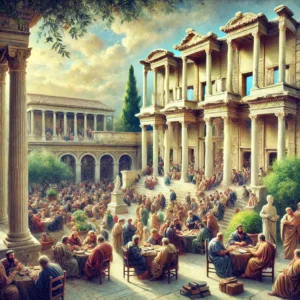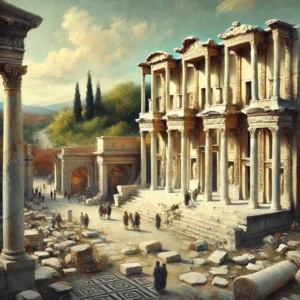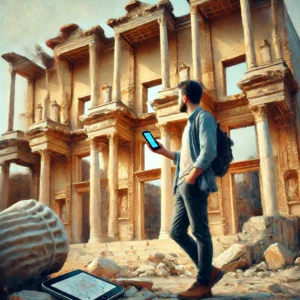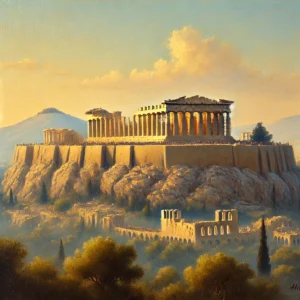When visiting Athens, it’s easy to get lost in the ancient world of the Acropolis, the Parthenon, and the Agora. However, there’s one site that often slips under the radar but deserves a spot on every traveler’s itinerary: Hadrian’s Library. Built by the Roman Emperor Hadrian in 132 CE, this grand complex was more than just a library—it was a cultural hub that reflected the emperor’s deep admiration for Greek heritage.
Here are 5 compelling reasons why Hadrian’s Library should be on your Athens itinerary.
- A Testament to Roman Influence in Athens

While Athens is famous for its classical Greek monuments, Hadrian’s Library is a shining example of the Roman imprint on the city. Built during Hadrian’s reign, the library is a symbol of the emperor’s vision to restore Athens to its former glory as a center of knowledge and culture. The massive columned façade and spacious courtyard reflect Roman architectural grandeur while blending seamlessly with Greek traditions.
As you walk through the ruins, you’ll notice the Corinthian columns that lined the entrance, along with the remains of the rooms that once housed scrolls, lecture halls, and reading spaces. It’s a place where Roman Athens comes alive, offering a glimpse into the fusion of two great civilizations.
- A Cultural and Intellectual Hub

Hadrian didn’t just build a library; he built a cultural complex. The library contained more than just books—its grounds were home to lecture halls, philosophical discussions, and intellectual gatherings. It was a place where scholars, philosophers, and students could come together to learn and share ideas.
The vast courtyard was an open space for reflection and debate, surrounded by colonnades and lush gardens. Hadrian’s vision was to create an Athenian Renaissance, where Greek philosophy, literature, and education would thrive under Roman rule. Visiting the site today, you can almost imagine the vibrant discussions that once echoed through these halls.
- Stunning Architecture and Ruins

The ruins of Hadrian’s Library may not be as complete as the Parthenon or the Erechtheion, but they still showcase the architectural brilliance of the Roman period in Athens. The massive outer wall, which originally stood at 100 meters in length, hints at the library’s grand scale, while the columns and remnants of Roman arches give a sense of the grandeur it once possessed.
As you explore the site, you’ll encounter the remains of marble columns, intricate stone carvings, and fragments of the original mosaic floors that once adorned the complex. The site offers a tranquil contrast to the hustle and bustle of central Athens, allowing visitors to quietly reflect on the beauty of Roman architecture.
- A Hidden Gem in the Heart of Athens
Unlike the Acropolis or the Temple of Olympian Zeus, Hadrian’s Library is often overlooked by tourists, making it a peaceful escape from the busier ancient sites. Located just a short walk from Monastiraki Square, the library is tucked away behind bustling streets filled with cafes and shops. Despite its central location, it remains relatively quiet, providing a more intimate and reflective experience for those who visit.
Its proximity to other key landmarks, like the Roman Agora and Monastiraki Flea Market, makes it easy to fit into any day of exploration. Whether you’re starting or ending your day in the area, Hadrian’s Library offers a calm, historical break from the energy of Athens’ busy streets.
- An Insight into Hadrian’s Legacy
Hadrian, one of the most influential Roman emperors, had a special relationship with Athens. He admired Greek culture and sought to revive it during his reign, commissioning several monumental projects across the city, with the library being one of the most important. By visiting Hadrian’s Library, you’re stepping into a piece of the emperor’s legacy—one that continues to influence Athens to this day.
The library is part of a larger network of Hadrianic monuments, including Hadrian’s Arch and the Temple of Olympian Zeus, making it a key stop for anyone interested in the Roman influence on the Greek capital. As you stand among the ruins, you’ll feel connected to a time when Athens was not only a symbol of the ancient world but also a thriving part of the Roman Empire.
A Must-Visit for History Lovers

Hadrian’s Library offers a unique window into Roman Athens, blending intellectual history, architecture, and the personal legacy of one of Rome’s greatest emperors. Whether you’re a history buff, an architecture enthusiast, or simply a curious traveler, this site provides a quieter, but equally rich, experience in the heart of the city.
Make sure to add Hadrian’s Library to your Athens itinerary, and explore it with our digital city tour map, complete with detailed guides, walking routes, and historical facts to bring the ruins to life. It’s the perfect way to uncover the forgotten gems of ancient Athens.






